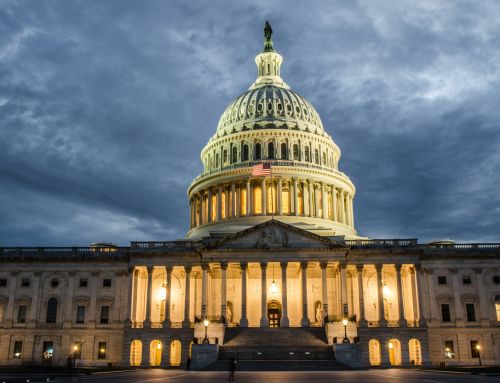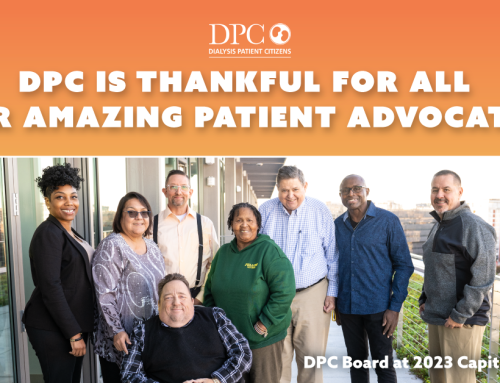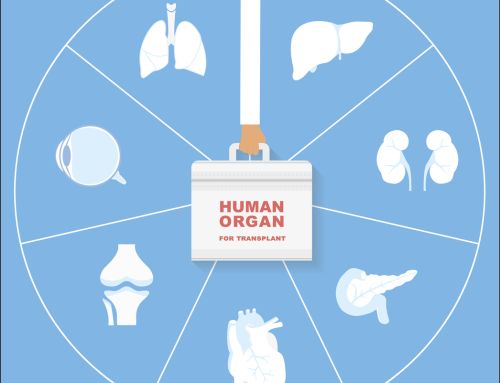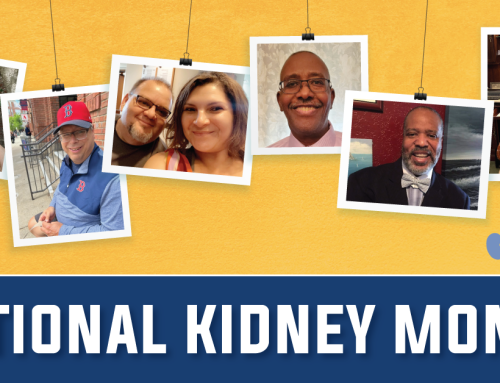Each year—typically during the summer—the Centers for Medicare and Medicaid Services (CMS) puts out rules for how they are going to pay for dialysis treatment. The rules reflect CMS’ latest policies, and organizations have the opportunity to provide feedback about the rules before they go into effect on January 1.
DPC provided feedback to CMS regarding their End-Stage Renal Disease (ESRD) Annual Payment rule. DPC’s letter addresses the following important topics for improving ESRD patient care:
- Protect Access for Costlier Patients by Completing Reconsideration of Case-Mix Adjusters
- Protect Access for Patients in Disadvantaged Regions by Addressing Social Risk Factors
- Focus the ESRD QIP on Measures Important to Patients
- Charting the Future of Kidney Care in Medicare
We hope that CMS will revise the rule as a result of our feedback in order to ensure patients with kidney disease receive the best possible care. DPC will continue to elevate the patient voice by advocating for favorable public policy.
Read DPC’s full letter to CMS below:
Seema Verma, Administrator
Centers for Medicare & Medicaid Services
200 Independence Avenue, SW
Washington, DC 20201
Re: CMS-1732-P – 2021 Medicare End Stage Renal Disease Payment Rule
Dear Administrator Verma:
Dialysis Patient Citizens (DPC) writes to offer its comments on the above referenced proposed rule.
DPC’s membership, currently 28,000, is restricted to kidney disease patients and their family members. DPC is a patient-led organization. Our by-laws require that the President, Vice President and at least 51% of the Board be current dialysis patients. The non-dialysis patients serving on our Board are former dialysis patients with kidney transplants. Nearly all our volunteer board members have represented their peers on CMS technical expert panels and/or advisory committees of other health care organizations such as the National Quality Forum and Patient-Centered Outcomes Research Institute. DPC also conducts an Annual Membership Survey to ascertain patients’ experiences with their care and views on health policy issues. DPC is committed to promoting access to high-quality dialysis care for individuals with ESRD; to prevention of, delayed onset of, and safe transition to ESRD among individuals with chronic kidney disease; and access to kidney transplantation as well as to other alternatives to dialysis that may emerge.
Because CMS has refrained from introducing new policy in this year’s payment rules, our comments will necessarily focus on longstanding issues not addressed by the ESRD NPRM. In one case this year, an important policy decision was made, but hidden in a report from another HHS operating division, and we will offer comments on that. While it is understandable that the Agency does not want to overload stakeholders with new policies during a public health emergency, some proposals were aimed at reducing providers’ burden and therefore were appropriate topics of rulemaking despite the pandemic.
Protect Access for Costlier Patients by Completing Reconsideration of Case-Mix Adjusters
Kidney stakeholders, including DPC, have long expressed concerns about the illogical implementation of case-mix adjusters in the ESRD PPS. A Technical Expert Panel on this subject was convened in 2018, yet there has been no action taken nearly two years later.
Policymaking around adjusters should be driven both a subjective and an objective element. The subjective element is: Do providers in fact think, or are they likely to think, that serving a particular subgroup of patients will be less lucrative, such that they might decline to serve this subgroup? The objective element is: Can the increase in cost be quantified, verifying the subjective belief and enabling the payer to even out the costs?
An accurate analysis of these cost factors is important to guaranteeing access to care for all patients. We are concerned that in the past, the agency has proceeded to the objective element without considering the subjective element, thereby confounding the exercise. The agency has employed regressions at the clinic level—not the patient level—to guess at which patients might be costlier, rather than beginning with hypotheses as to which patients might be costlier. Ideally, these hypotheses would be formed by interviewing clinicians, technicians, and executives about their perceptions of which patients are costlier. In fact, during the December 2018 Technical Expert Panel deliberations, provider representatives identified specific factors. When this step is skipped, what ensues is “data dredging” that bears no relationship to the policy purpose in identifying adjusters.
We are disappointed that the issues discussed at the TEP have not been addressed. While the TEP made no recommendations, the thrust of its deliberations was clear: time-and-motion studies of clinic personnel as they serve different categories of patients would identify the costlier ones and quantify the additional resource use they require. We urge the Agency to employ a contractor to conduct such studies and rationalize the case-mix adjusters in the PPS.
Protect Access for Patients in Disadvantaged Regions by Addressing Social Risk Factors
The IMPACT Act mandated a report from the Assistant Secretary for Planning and Evaluation (ASPE) on social risk factors and performance under federal value-based payment systems. The report was released in late 2016 along with a commentary in NEJM signed by the contractors and by Drs. Conway and Goodrich, who led CCSQ at that time. That commentary noted that
[B]eneficiaries with social risk factors had worse outcomes on many quality measures, regardless of the providers they saw, and dual enrollment status was the most powerful predictor of poor outcomes. Dually enrolled beneficiaries had poorer outcomes on process measures (e.g., cancer screening), clinical outcome measures (e.g., diabetes control, readmissions), safety (e.g., infection rates), and patient-experience measures (e.g., communication from doctors and nurses), as well as higher resource use (e.g., higher spending per hospital admission episode).
The commentary stated that “measures should be individually examined to determine whether adjustment for social risk factors is appropriate to make them as equitable as possible. This determination will depend on the measure and its empirical relationship to social risk factors,” noting, for example, that the case for adjusting process measures is much weaker than the case for adjusting outcome measures. The commentary also recommended “targeted financial incentives to reward achievement or improvement specifically for socially at-risk beneficiaries. Such targeted incentives could help harness the power of value-based payment to improve care and outcomes for our most vulnerable patients, and simultaneously offset any real or perceived disincentives under value-based purchasing programs to caring for these beneficiaries.”
As we have stated in previous comment letters, we believe the optimal strategy for implementing both of these approaches is peer grouping of facilities that share similar characteristics, so that providers compete on a level playing field and those that do well in serving at-risk patients are rewarded with payment boosts (in the QIP program, this is more accurately stated as not punished by payment cuts).
More recently ASPE released a second report which can only be described as an about-face, repudiating the points made in the NEJM commentary. The 2020 report conflates two separate problems—disparities in care, which are not intended to be addressed by adjustments; and access to care, which is. To say that peer grouping does not resolve disparities is a non sequitur and a red herring; case-mix adjusters don’t resolve disparities either, but nobody insists they be abandoned for that reason.
What we infer from the timing of this reversal, in the face of static underlying data, is that a change in leadership within the Center for Clinical Standards and Quality permitted career staff to reassert their longstanding opposition to adjusters. It would seem that the bureaucracy has been “waiting out” senior leaders on this issue since as early as 2010, when Dr. Berwick asked CCSQ to brief him on options for using Jarman Scores but no such briefing followed.
Here again, the Agency seems to have lost sight of the purpose of adjusters—ensuring patient access. Dialysis patients are uniquely vulnerable to deprivation-related payment cuts because of the chain structure of dialysis clinics—poor financial performance in comparison to performance in affluent regions is highly visible to decisionmakers. If the Agency elevates the avoidance of “masking disparities” over patient access then ultimately disparities are exposed by payment reductions, which invites retrenchment in clinics serving the disadvantaged. This is a victory of a peculiar sort of formalism over substance.
The PPS TEP identified dual Medicare/Medicaid eligibility as contributing to increased resource use in clinics. The health effects of poverty have been brought into sharper focus by the fact that dual eligibles have been hospitalized for COVID -19 at five times the rate of Medicare-only eligibles. We know that the QIP has led to less money for clinics serving duals, even as operations in those clinics are more resource-intensive. The Agency needs to get ahead of this issue, and not wait to fix it until after clinics close.
Focus the ESRD QIP on Measures Important to Patients
We are not sure the Agency’s “Meaningful Measures” initiative led to much improvement in the QIP. There is still a large number of measures, sending a somewhat muddled signal to providers as to which dimensions of quality they should be attentive to. We urge the Agency to convene stakeholders for a top-to-bottom review of current quality measures, as well as of dimensions of quality that are not currently measured. Such a review should give greater weight to the views of patients as to what dimensions are important to them—it has been well-established that patient and clinician priorities diverge.
There also needs to be greater deliberation on whether dimensions of quality are best captured by clinical data, by CAHPS questionnaires, or by patient-reported outcome measures. Shaping of the QIP has been dominated by incremental changes, rather than driven by a holistic view of how it can best achieve improvements in outcomes and experience for patients.
A pay-for-performance program should use payment adjustments to incentivize improvement in areas where the current payment structure may be deficient. One advantage of the longitudinal nature of renal therapy and payments per treatment is that increased survival is rewarded—unlike, say, cancer treatment, if a patient survives six years instead of three, kidney care providers are doubly compensated. As such, there is no need for a mortality measure in the QIP.
Where we think incentives are most poorly aligned is in the area of transplant referral. The assignment of transplant education and referral duties to dialysis providers may be an administrative convenience for Medicare, but there is no logic in giving this role to a provider that stands to lose economically from a successful referral.
If dialysis providers are to continue in this role, we believe there needs to be a rigorous measurement regime to ensure they are fulfilling it. Dr. Rachel Patzer has laid the groundwork for developing a Transplant Referral measure and we urge the Agency to build on her research to complete a valid measure for the QIP. Currently the Agency is funding work on a Life Goals measure even as a parallel, identical, foundation-funded effort is under way. This seems to us a poor use of scarce resources. While the Meaningful Measures initiative promised more of a big-picture view of the measures in value-based purchasing, there is still a ways to go in appropriately structuring the QIP.
Charting The Future of Kidney Care in Medicare
As the purchaser of the lion’s share of kidney care in the U.S., Medicare is in a position to spur, or retard, improvements in patient care. Responsibility for kidney care within CMS is becoming more diffused as new options are offered to patients and providers, and as responsibility for increasing transplantation and home dialysis was assigned to the Innovation Center. By our count, kidney care policymaking is now shared by five CMS components or subcomponents: CM-FFS, CM-CPC, CCSQ, CMMI, and OFM. Sometimes it appears that the components are working at cross-purposes, as when CMMI proposed to overlay a second performance-based payment adjustment mechanism, the ETC, on top of the existing QIP.
We urge the Agency to collaborate internally, and externally with stakeholders, in developing a broader, shared vision of the future of kidney care in Medicare and a consensus strategy for reaching it. The physical cloistering of Agency personnel outside Baltimore—an isolation now reinforced by COVID-19 restrictions—can result in policymaking that inadequately recognizes the roles of patient choices, clinician judgment, and market forces in organically shaping kidney care delivery.
We have identified four areas where we think the Agency needs to anticipate and constructively react to developments in kidney care:
Facilitating integrated care for dialysis patients. We believe that integrated models represent the future of payment for and delivery of kidney care in the U.S. Evidence thus far, from ESCO and C-SNP sites, indicates that such models reduce avoidable complications and give patients more healthy days at home. These models can be pursued either through Medicare Advantage plans or voluntary total-cost-of-care (TCOC) programs for providers.
We are concerned that the Agency is missing opportunities to make integrated care available to more ESRD patients. The recent Medicare Advantage regulation, which stripped network adequacy protections for dialysis and no other provider type, appeared intended to signal to insurers that they could remove clinics from their networks with impunity. This will have the result of making it less likely that a patient will be able to enroll in a plan that has their home clinic in-network, which we think, practically speaking, is a condition patients will insist upon.
The successor to the ESCO program, the Comprehensive Kidney Care Contracting (CKCC) program, like too many other Innovation Center models emphasizes savings to the government and risk for providers over serving the maximum possible number of beneficiaries with chronic conditions. We fear that this program may attract only nominal participation from providers when what is sorely needed is greater scale. If CKCC and other voluntary TCOC models are designed primarily as cost containment programs, where, we ask, is the care coordination program for ESRD beneficiaries in FFS? While we are currently advocating in Congress for a statutorily-mandated alternative, we continue to hope the Agency will shift gears on its own. What we would like to see is this policy pronouncement from the Agency: Every dialysis patient should have access to a care coordination program at their home clinic.
Encouraging innovation within the ESRD bundle. We think TCOC models better encourage uptake of cost-effective, innovative technologies, but we recognize that fee-for-service payment is not going away, and that beneficiaries have a right to choose a viable Original Medicare option. With more new technologies in the pipeline thanks to the KidneyX project, it is important that the Agency signal to venture capitalists that a pathway to payment in the ESRD PPS will reward their investments.
As we have stated before, limiting additional payments to products that offer substantial clinical improvement maintains the integrity of the bundle by tying new money to avoidable hospitalizations or better quality of life. We again ask the Agency to indicate that such improvements will be rewarded beyond the two-year trial periods.
Securing Medicare Secondary Payer protections. The Medicare Secondary Payer 30-month coordination period saves money for Medicare while at the same time incentivizing commercial health plans to prolong CKD patients’ kidney function and stabilize the transition from CKD to ESRD. The efficacy of this protection relies on an accompanying provision of the law, which forbids “differentiation” in the benefits commercial plans offer to dialysis patients.
The non-differentiation requirement is under assault by employers, third-party administrators, and benefit consultants who are implementing plan designs that discriminate against dialysis patients. Providers have brought lawsuits challenging these plan designs, but federal judges who have decided these cases at the District Court level clearly do not understand this unique and unusual provision of Medicare law. These cases are now on appeal and Circuit Court decisions are due over the coming year. If circuit judges also misapprehend the meaning and purpose of this law, Medicare can expect a flood of new enrollments from ESRD patients whose insurers did not act to delay failure of their kidneys, to offer them home dialysis or transplants, or to obtain permanent access sites.
We urge staff from CM and OFM to watch this situation carefully and act in the event of unfavorable decisions. If the courts rule that private parties can’t enforce the non-differentiation provision, it will be up to the Agency to bring enforcement actions promptly to prevent a wholesale unravelling of MSP.
Encouraging home dialysis and transplant. Given the track record of CMMI mandatory models promulgated in the past, it is our hope and expectation that the ESRD Treatment Choices Model will not be finalized. If that is the case, the Agency will need to consider how best to follow through on achieving that initiative’s worthy goals. The option we have advocated is grant-funded demonstration projects to test multiple interventions. It may also be appropriate to emphasize measures relevant to home dialysis and transplant in the QIP, though we continue to believe that economic incentives for dialysis providers and nephrologists are not the principal barriers at work.
We urge the multiple components within CMS that oversee kidney care to convene stakeholders and academics to find consensus on a way forward. Further policymaking in this area should recognize the role of other, pre-Medicare insurers in paving the way to home dialysis and transplant among incident ESRD patients, and in particular, the perverse incentives for Medicaid programs and Medicaid managed care organizations to be indifferent to kidney failure among their enrollees. With the ACA’s expansion of Medicaid eligibility continuing to encompass more states—and probably gaining more enrollees due to the current economic situation—we can expect more ESRD Medicare beneficiaries coming from state Medicaid programs. As such, we hope that CMCS and state Medicaid directors will also be engaged in charting a future in this area.
In any event, the ETC NPRM should be officially withdrawn as soon as possible, to eliminate the uncertainty it has created for providers over the past year, which can only delay deployments of resources that should be serving patients right now.
Thank you for your consideration of our comments and concerns. If you have any questions or would like additional information, please do not hesitate to contact me or our Vice President of Public Policy Jackson Williams.
Respectfully submitted,
Hrant Jamgochian, J.D., LL.M.
Chief Executive Officer

























